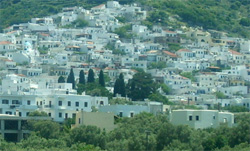|
Tragea (Naxos) |
||
|
|
Filoti With about 2000 people living there Filoti is the second biggest town after Naxos City. It is in the very heart of the Tragea. For years now Filoti during summer is overrun by excursion busses. It is proper mass tourism and - needless to say - with visible results. Apart from the place being anything but the allegedly unspoiled mountain village it during the day is packed with tourists.
Chalkio The second biggest
village in the Tragea is Chalkio. It is only 5 kilometres
from Filoti but quiet different. It basically remained a
quiet and unspoiled mountain village where Filoti became a
tourist spot.
Moni Moni is a small village in the Tragea. It is well known for its marble. The local quarry is in use until this very day. Most of the marble you see in Naxos City indeed comes from this quarry. Apiranthos There are many ways to attract tourists; the people from Apiranthos came up with their very own idea: They built four museums in their little village. That is remarkable and even more since all four are actually quite interesting. They have an archaeological museum, a geological one and two that deal with natural history. Give it a go. They are mostly free. One of them charges 2 Euro from what I remember. Zas Mount Zas with an
impressive 1003 metres is not only the highest mountain of
Naxos but of all the Cyclades islands. Getting up there is
pretty easy. There is no climbing involved. The view from the
top is terrific. When standing on top the world seems to be
ones oyster well at least Naxos and the surrounding islands.
It is quite impressive. The alternative is to start the trip from Filoti. Form there it takes 3 to 3.5 hours for the whole trip.
Koronos probably is the most picturesque of all villages on Naxos. All the houses are built in the traditional style (white and blue). The village is situated on a hill so instead of streets they mainly have stairways. Very few tourists get here. Most of them are hikers. There are a couple tavernas in Koronos. They are on the little road that leads through the village. Koronida
The most remote of
all the villages in the Tragea is Koronida.. It is about 12
kilometres south of Apollonas. To get there follow the inland
route from Naxos City towards Apollonas. In the little
village of Skado you come to a junction. Rather then going
straight to Apollonas turn left and take the long route to
Apollonas. It leads through Koronida. Busses All of the above mentioned are easy to reach by bus. There are a few busses every day and they do go all year. Even during winter up to five busses a day go to Chalkio and Filoti, still 2-3 to Apiranthos, Koronos, Koronida and Moni. In summer there are even more busses. There also is a regular bus from Apollonas to Filoti, Koronos, Koronida and Apiranthos. It goes 2-3 times a day. Last update 04/2008 |
|






